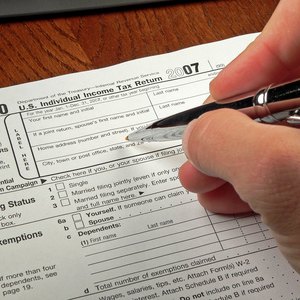
You don’t want to miss a tax break by failing to list your qualifying Individual Retirement Account (IRA) deductions. If you’ve been making contributions in past years to an IRA, you’re probably acquainted with Line 32 on your Form 1040, “U.S. Individual Income Tax Return.” If you’re a new contributor to an IRA, Line 32 is where you enter any allowable IRA deductions. Line 32 is in the section of your 1040 form that allows you to itemize adjustments to your gross earnings, which lowers your taxable income. But before you’re ready to enter an amount on Line 32, you have to meet a few requirements, do a little math and complete a worksheet.
Tips
If you are planning on incorporating IRA deductions into your tax return, Line 32 of IRS Form 1040 is the place to start. This particular component of Form 1040 includes 11 specific requirements that you can follow to ensure that you complete this process correctly.
Completing the 1040 Line 32 Checklist
The Form 1040 Line 32 instructions include a checklist of 11 requirements and additional guidelines that qualify your being able to claim any deductions for your IRA contributions. Some notable examples are:
- Your plan type. Only traditional IRAs qualify; Roth IRAs do not.
- Your age. You must be younger than 70 1/2 years to deduct any contributions.
- Your marital status. If you’re married, you must file a joint return if your spouse has IRA contributions.
-
Your income.
Your income must be earned, which is different than unearned income, to claim any IRA tax deductions. Earned income includes compensation from hourly wages, salaries, tips and commissions. Unearned income includes compensation such as dividends, capital gains and pensions. An exception is alimony payments. Any alimony you received, even though it is unearned, is considered earned income for IRA deduction purposes. * Your contribution to an employer's retirement plan. If you are covered by your employer's retirement plan in addition to your traditional IRA, your IRA deduction may be reduced.
After you review the 11-item checklist, complete the worksheet that’s included in your 1040 instructions. The worksheet walks you through one line at a time, prompting you to enter figures that determine whether you are eligible for the IRA deduction benefit and, if so, how much you can enter on Line 32 of your 1040.
The contributions you make to your IRA are tax-deferred, which means they're not taxed when they're removed from your earnings. But in your retirement years, as you withdraw the funds you've been setting aside in your IRA, you'll typically pay taxes on the money then.
Income Limits for the 2018 Tax Year Subject to Phase-Out Guidelines
If you have a retirement plan through your employer, your IRA deduction is reduced (also called "phased out"), potentially to $0, based on your income and filing status if your modified AGI is:
- Greater than $101,000 but less than $121,000, and your filing status is married, filing jointly or qualifying widow(er).
- Greater than $63,000 but less than $73,000, and your filing status is single or head of household.
- Greater than $0, but less than $10,000, and your filing status is married, filing separately.
Income Limits for the 2017 Tax Year Subject to Phase-Out Guidelines
For the tax year 2017, the Adjusted Gross Income (AGI) IRA deduction limits are lower, as follows:
- Greater than $99,000 but less than $119,000, and your filing status is married, filing jointly or qualifying widow(er).
- Greater than $62,000 but less than $72,000, and your filing status is single or head of household.
- Greater than $0, but less than $10,000, and your filing status is married, filing separately.
References
Writer Bio
Victoria Lee Blackstone was formerly with Freddie Mac’s mortgage acquisition department, where she funded multi-million-dollar loan pools for primary lending institutions, worked on a mortgage fraud task force and wrote the convertible ARM section of the company’s policies and procedures manual. Currently, Blackstone is a professional writer with expertise in the fields of mortgage, finance, budgeting and tax. She is the author of more than 2,000 published works for newspapers, magazines, online publications and individual clients.
